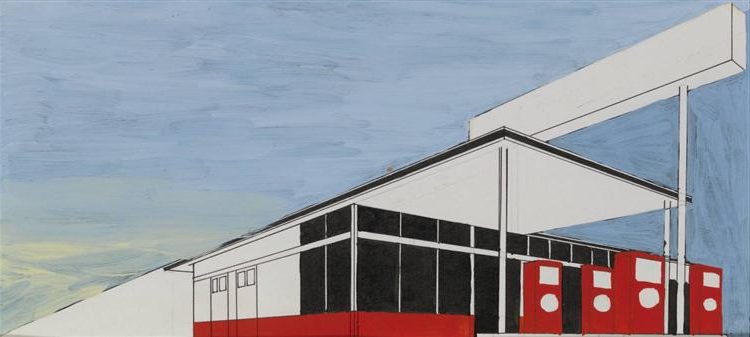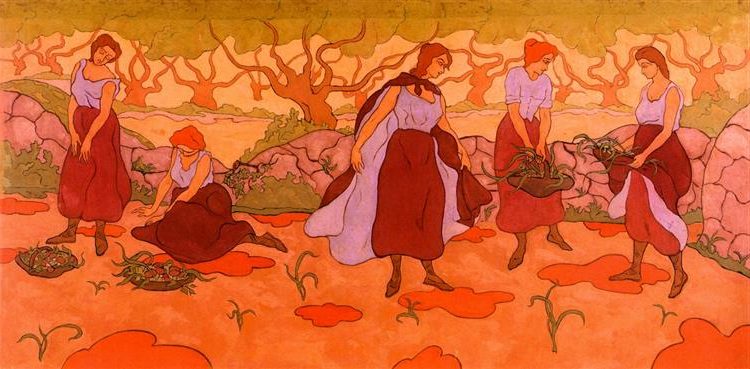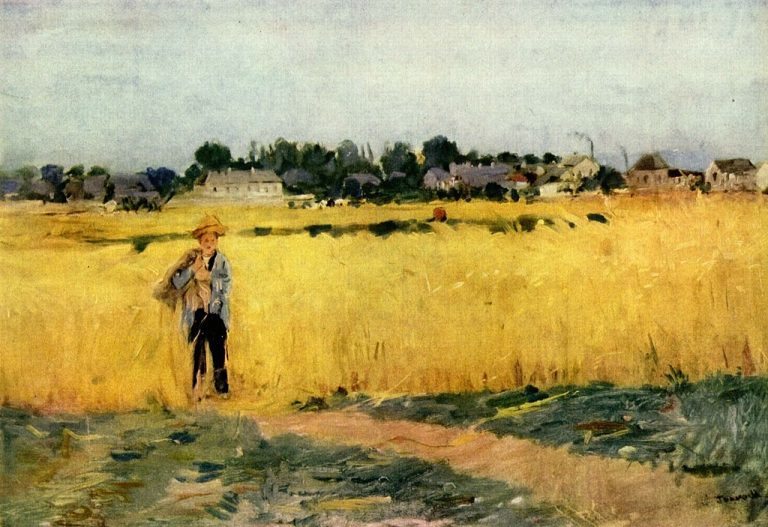Max Beckmann Painter: Exploring the Legacy of German Expressionism
Born: February 12, 1884, Leipzig, Kingdom of Saxony, German Empire
Death: December 27, 1950, New York, U.S.
Art Movement: New Objectivity, Expressionism
Nationality: German
Influenced By: Edvard Munch, Henri Rousseau
Max Beckmann Painter: Exploring the Legacy of German Expressionism
Life and Career of Max Beckmann
Max Beckmann’s life journey shaped his distinctive artistic vision. His experiences during turbulent historical periods transformed his style from traditional to more symbolic and expressive work.
Early Years and Artistic Development
Max Carl Friedrich Beckmann was born on February 12, 1884, in Leipzig, Germany. He showed artistic talent from an early age.

Triptych of the Temptation of St. Anthony, 1936–1937
In 1904, Beckmann moved to Berlin, where he established himself in the German art scene. His early works demonstrated influences of Impressionism and academic styles.
The large-scale painting “The Sinking of the Titanic” (1912) marked his initial approach to history painting, inspired by Géricault’s dramatic compositions.
By his late twenties, Beckmann had achieved considerable success and recognition in Berlin’s artistic circles. His technical skill and ambitious compositions earned him respect among his peers.
Impact of World War I on Beckmann’s Work
World War I profoundly transformed Beckmann’s art and worldview. He served as a medical orderly, witnessing extreme suffering and violence firsthand.
The traumatic experiences of war shattered his previous artistic approach. Beckmann abandoned his earlier style in favor of more distorted forms, harsh outlines, and compressed spaces that better expressed the psychological impact of modern life.
After the war, his work became increasingly symbolic and expressionist. He developed a distinctive visual language using cramped spaces, angular figures, and bold black outlines.
This period established him as a key figure in German Expressionism, though he rejected being labeled as part of any movement.
Exile and Life After Germany
When the Nazis came to power in 1933, Beckmann’s work was condemned as “degenerate art.” He lost his teaching position in Frankfurt and faced increasing persecution.

Still Life with Candles and Mirror, 1930, by Max Beckmann
In 1937, he fled to Amsterdam where he lived in self-imposed exile for ten years. Despite difficult circumstances, this period was artistically productive, with Beckmann creating some of his most powerful triptychs and symbolic works.
After World War II, Beckmann relocated to the United States in 1947. He taught at Washington University in St. Louis and later at the Brooklyn Museum Art School in New York. His final years in America brought renewed recognition and artistic freedom.
Beckmann died suddenly of a heart attack in New York City on December 27, 1950, while walking to see his own exhibition at the Metropolitan Museum of Art.
Artistic Style and Major Works
Max Beckmann developed a distinctive artistic style that blended expressionist techniques with symbolic imagery. His work evolved dramatically through his career, reflecting his experiences of war, politics, and personal struggles.
Development of Expressionism in Beckmann’s Art
Beckmann’s early works showed influences of Impressionism and academic styles. However, after serving as a medical orderly in World War I, his art transformed dramatically.
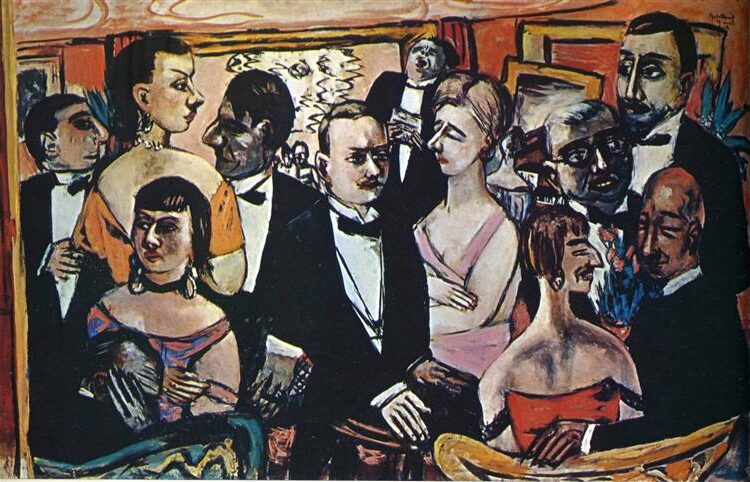
Paris Society, 1931–1947, by Max Beckmann
The war’s trauma pushed him toward a more angular, distorted style with darker themes.
By the 1920s, Beckmann had developed his signature style: compressed space, bold black outlines, and vibrant colors. He rejected pure abstraction, instead creating densely packed compositions filled with symbolic figures.
Unlike other German Expressionists who embraced primitive styles, Beckmann maintained technical precision while distorting reality to express emotional and psychological states. His work combined elements of New Objectivity with a personal mythological system.
The confined spaces in his paintings often reflect his feelings about modern life’s constraints and anxieties.
Notable Art Series and Standalone Pieces
Beckmann’s triptychs rank among his most significant works. “Departure” (1932-35), his first major triptych, uses symbolic figures to address themes of freedom and tyranny during the Nazi rise to power.
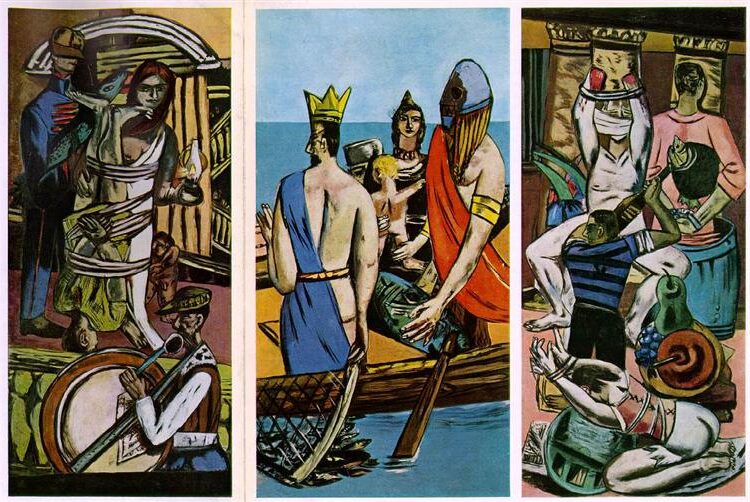
Departure, 1932–1935, by Max Beckmann
“Night” (1918-19) depicts a brutal home invasion, expressing the violence and chaos of post-war Germany. Its cramped composition and distorted figures create a sense of claustrophobia and terror.
His “Carnival” series explores the theater of human existence through circus and cabaret scenes. These works use masked performers and staged settings as metaphors for life’s deceptions.
“The Dream” (1921) and “Hell of Birds” (1938) showcase his complex symbolic language, combining personal mythology with social commentary.
Beckmann’s landscapes, though less common, offer powerful compositions with symbolic elements embedded in natural settings.
Contributions to Portraiture, Self-Portraits, and Prints
Beckmann created over 85 self-portraits throughout his career. These works serve as psychological documents of his changing identity and artistic development.
His self-portraits often show him in formal attire or as characters from his personal mythology. The intense gaze and rigid posture in these works reflect his determination and scrutiny of self.
Beckmann’s portraits of others capture psychological depth rather than mere likeness. He portrayed cabaret performers, friends, and patrons with empathy and symbolic elements.
His printmaking, particularly his lithographs and drypoint etchings, allowed him to explore narrative sequences. The “Hell” portfolio (1919) contains some of his most politically charged images responding to post-war German society.
Beckmann’s figural style emphasized the human form’s expressive potential through exaggeration and distortion while maintaining recognizable forms.
Legacy and Recognition
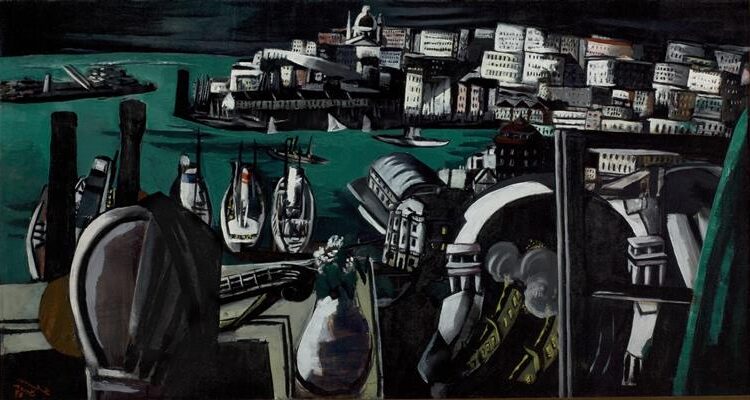
The Harbor of Genua, 1927, by Max Beckmann
Max Beckmann’s impact on modern art extends far beyond his lifetime. His powerful imagery and emotional depth continue to influence artists and captivate museum visitors worldwide.
Exhibitions and Retrospectives
The Museum of Modern Art in New York has played a crucial role in preserving Beckmann’s legacy through major exhibitions. After his death in 1950, MoMA hosted several significant retrospectives that brought his work to American audiences.
The Kunsthalle Mannheim in Germany organized a landmark exhibition in 1984 to commemorate the centenary of his birth. This show traveled to several European museums and renewed scholarly interest in his contributions.
The Metropolitan Museum of Art held a comprehensive retrospective in 2003 titled “Max Beckmann in Exile,” focusing on his later works created after leaving Nazi Germany. The exhibition catalog, with essays by leading scholars, became an important reference for Beckmann studies.
Collections and Influences on Modern Artists
Beckmann’s works are prominently featured in major museum collections. The National Gallery of Art in Washington, DC houses several important paintings and prints, displayed both in the main building and the Sculpture Garden along Constitution Avenue.
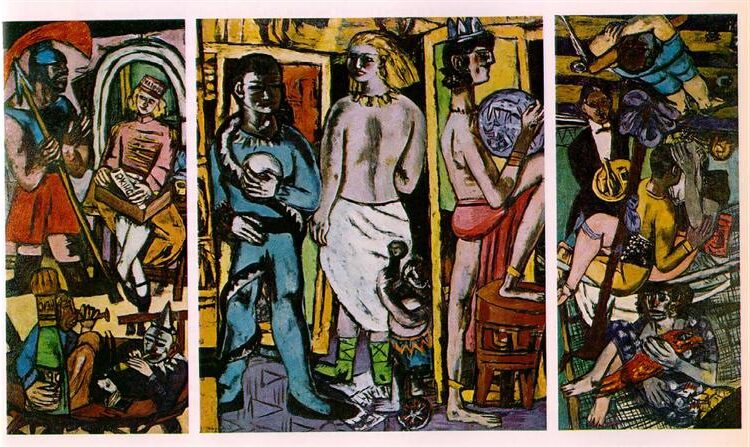
The Acrobats, 1939, by Max Beckmann
His expressionist style, with distorted figures and complex symbolism, influenced numerous post-war artists. Neo-expressionist painters of the 1980s drew inspiration from his bold use of color and emotional intensity.
German art publisher Reinhard Piper was instrumental in promoting Beckmann’s early career, publishing his prints and writings. These publications helped establish Beckmann’s reputation as both a visual artist and intellectual.
Contemporary artists continue to cite Beckmann’s unflinching examination of human suffering and resilience as an inspiration for their own socially engaged art practices.
Frequently Asked Questions
Max Beckmann’s life and work provoke many questions due to his complex artistic journey and distinctive style. Here are answers to some common inquiries about this influential German painter.
What themes are commonly depicted in Max Beckmann’s artworks?
Beckmann’s art often explored human suffering, violence, and the chaos of modern life. He frequently depicted crowded, claustrophobic scenes filled with figures engaged in mysterious activities.
His work also examined themes of mythology, spirituality, and the circus. Beckmann used these motifs to comment on power, politics, and the human condition.
Personal experiences, particularly from wartime, influenced his themes. His paintings contain symbols and metaphors that reflect his views on society’s darkness and humanity’s struggles.
How did World War I influence Max Beckmann’s painting style?
World War I dramatically transformed Beckmann’s artistic approach. Before the war, he worked in a more traditional, academic style, but his wartime medical service exposed him to terrible suffering.
The trauma of seeing wounded soldiers shifted his style toward more angular, distorted forms. His post-war paintings feature compressed space, harsh lines, and vivid colors that convey psychological intensity.
The war prompted Beckmann to abandon impressionist influences in favor of a more expressionist approach. His work became more symbolic and emotionally charged as he processed his wartime experiences.
What is the significance of the triptych format in Beckmann’s work?
Beckmann produced numerous triptychs—three-panel paintings—which allowed him to create complex narratives. This format, traditionally used for religious altarpieces, gave his work a sense of ceremony and importance.
His triptychs often presented different but related scenes across the panels. Famous examples include “Departure” (1932-35) and “The Beginning” (1949), which explore themes of exile, freedom, and human fate.
The triptych format enabled Beckmann to juxtapose contrasting ideas and create visual tension. He used this structure to convey complicated stories about human experience and existence.
Can you describe the evolution of Beckmann’s self-portraits over his career?
Beckmann created over 80 self-portraits throughout his life, showing his changing artistic vision and personal circumstances. His early self-portraits appear more conventional, with realistic proportions and traditional techniques.
After World War I, his self-depictions became more stylized and psychologically intense. He often portrayed himself in costume or with symbolic objects, suggesting different roles and identities.
During his exile years, his self-portraits reflect uncertainty and displacement. His final self-portrayals, created in America, show a blend of confidence and contemplation as he established himself in a new country.
Which artistic movements is Max Beckmann associated with?
Though often linked with German Expressionism, Beckmann rejected this label. His work shares the movement’s emotional intensity and bold style but maintains its own distinct character.
Beckmann had connections to New Objectivity (Neue Sachlichkeit), a post-World War I movement focusing on harsh social realities. His unflinching portrayal of modern life aligned with this approach.
Despite these associations, Beckmann remained fiercely independent. He created his own unique visual language that drew from expressionism, cubism, and traditional painting while transcending easy categorization.
What are the key characteristics of Max Beckmann’s technique and medium choices?
Beckmann primarily worked in oil paint. He applied it with bold, confident brushstrokes. His paintings feature strong black outlines that define forms and create visual impact.
Color played a crucial role in his work. Combinations create psychological tension. He often used contrasting hues to divide space and enhance the emotional quality of his compositions.
Beyond painting, Beckmann was a skilled printmaker. He created numerous lithographs and woodcuts. These works showcase his masterful draftsmanship and ability to convey powerful ideas through simplified forms.



